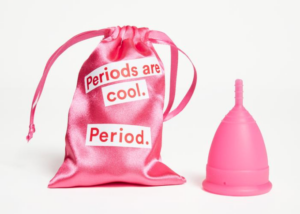Let’s talk about periods: the little magic flow that greets lucky ladies once a month can be downright annoying, painful, and – let’s face it – messy. We all fear the dreaded squelch in our undies when it’s arrived. From travelling to your local shop to pay for overpriced tampons and pads, to having to constantly check that you haven’t bled through your clothing, your period can be a stressful time. Isn’t being a woman great?

Periods are a pain for many; there isn’t a woman I know that hasn’t complained about her time of the month. I’m no different.
I became sick of allocating my savings to feminine hygiene products once a month, running out and having to run to the shop with wadded up toilet paper in between my legs, so I decided I needed a change.

I had heard about menstrual cups in passing conversation and through some online chats before, but I never really understood what they were and how they were used. Despite that, I was willing to give it a go and stop the never-ending cycle of spending money on pads and tampons. I also felt there had to be a better solution to dealing with our periods other than using paper and plastic. According to the ABC, “disposable products can have a big impact on landfill — every pad takes around 500-800 years to biodegrade.” This may be a shocking statistic for most women. Peter Hadfield from Sydney Water told the ABC that “Sydney Water has to remove hundreds of tonnes of non-degradable products from our network every year and it costs us and other utilities millions of dollars to remove these products.” Something to consider before flushing a tampon down the toilet.

I never liked the idea of sticking a bleached paper cylinder (also known as a tampon) up my vagina. They can dry out your intimate area, and splurging on organic tampons which are even higher in price was a huge no-go! Plus, when you use tampons, you’re increasing your risk of toxic shock syndrome (TSS) – a rare illness caused by infection of certain bacteria. In rare cases, the infection can lead to death if a tampon is left in the vagina for a long period of time encouraging the bacteria to grow.
According to Huff Post “the average woman endures some 456 total periods over 38 years, or roughly 2,280 days with her period — 6.25 years of her life,” equalling a whole bloody lot of feminine hygiene products in a woman’s lifetime. So, ladies, how good would it be to never run out of pads and tampons again?
I binge-watched some YouTube videos about menstrual cups and Googled some articles and reviews about the environmental and economic benefits. According to 1millionwomen.com.au, “20 billion tampons and pads are being dumped into landfill each year. The polyethylene plastic in pads can take hundreds of years to decompose. In fact, conventional pads can contain the equivalent of about four plastic bags.” I knew from here I needed to make the change.
And so, I was ready to take the plunge.

Say hello to the menstrual cup. It’s probably best described as a feminine hygiene product that is inserted into the vagina during menstruation. The cups are made from flexible medical grade silicone and shaped like a bell, with a stem used for insertion and removal. When you first see the cup, you may be wary about inserting and removing it, but with the proper “fold” techniques and a little practice, I promise you it’s no harder than inserting a tampon.

We’ve all had that first-time experience learning how to insert a tampon, and it may have not been pretty, but the learning curve for inserting the cup is extremely easy to get the hang of, and better yet – no dryness!
I found that the benefits in making the switch from pads and tampons to a menstrual cup far exceeded the cost, but also to reduce my carbon footprint on the earth by reducing my waste – yep, these little babies are reusable! In one day, The Ocean Conservancy collected “27,938 used tampons and applicators on our world’s beaches,” adding up to the 1.5 BILLION ITEMS OF SANITARY PROTECTION THAT ARE FLUSHED EVERY YEAR. The biodegradability makes the menstrual cup a viable resource for women who care about the environment and care to reduce their waste. According to ABC.net, “the average Australian woman uses around 10,000-12,000 disposable menstrual products in their lifetime.” That’s a statistic I no longer wanted to be a part of.
For many women, tampons can be the cause of great discomfort, can lead to rashes, an embarrassing odour, and dryness. Tampons are recommended to be worn on average 4-8 hours but depending on how often you use the toilet, how heavy your flow is, and how much time you want to spend in the bathroom, the inconvenience is REAL. Luckily, menstrual cups can be worn for up to 12 hours. T-W-E-L-V-E hours! Count them! So ultimately, you don’t have to worry about running to the toilet in the middle of your hectic day at work or uni, and worrying your annoying tampon string getting peed on – the HORROR. The silicone stem will make it easy to wipe and go, without mess. You don’t have to worry about emptying your cup until you’re home after a busy day. If for any reason you need to empty your cup while in a public bathroom, you can simply carry wipes in your handbag, empty the cup in the toilet, wipe the cup clean and you’re good to go.
It’s important to clean and sanitise your cup before and after your cycle. There are multiple sanitary wipes and soaps you can purchase, or you can stick with the old-fashioned way of boiling your silicone cup to get rid of any bacteria build-up from your cycle. While on your period, you can simply wash menstrual cups in hot water and soap before reapplication.
All in all, the menstrual cup has proven to be a viable option for me, allowing me to stray from pads and tampons that irritate my body and pollute our planet. Menstrual cups are cost-effective, clean, biodegradable, sanitary, oh so convenient, and are my new favourite bloody thing. I’ve been converted! I see the menstrual cup as an extremely viable option for ALL women who want a clean, odourless, ecological, convenient, and economical option for their monthly cycle. There are tons of menstrual cups available on the market, ranging in price, size, and durability. I implore every woman to do a little research of their own to see if the change is right for them! I suspect that if you’re reading this article then you’re curious (just like I was!), and I can honestly say I’m so happy I made the change. I think you will be too.
Happy menstruating!

